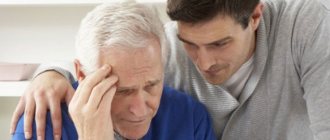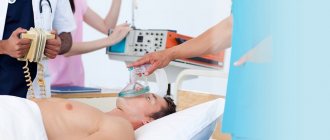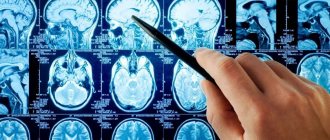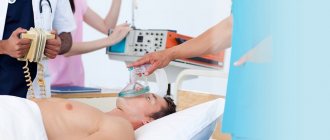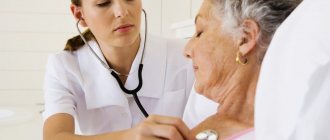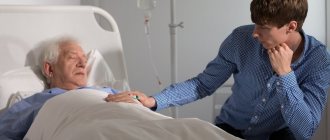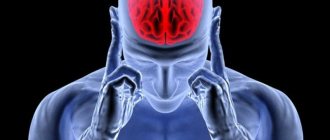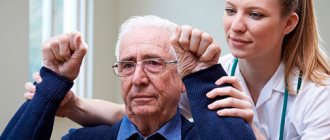24.11.2016
Pinchuk Elena Anatolyevna
Deputy chief physician for medical work, kmn, neurologist, doctor of physical and rehabilitation medicine
Lipovka Nadezhda Sergeevna
Head of the Department of Medical Rehabilitation, Physician of Physical and Rehabilitation Medicine, Neurologist
Sobolev Arkady Igorevich
Doctor of physical and rehabilitation medicine, neurologist
Stroke is a serious nervous disease due to disturbances in the vital functions of the brain. Depending on the location of the lesion, patients may experience different symptoms. There are hemorrhagic stroke (rupture of blood vessels in the cerebral cortex, hemorrhage) and ischemic stroke (the left side of the human brain is affected due to blockage of blood vessels by blood clots or plaques). Doctors name the following causes of stroke as the most likely:
- Diseases of the cardiovascular system;
- Blood composition disorders;
- Some infectious diseases;
- Diabetes;
- Abuse of hormonal and contraceptive drugs;
- Frequent migraines accompanied by aura;
- Osteochondrosis of the cervical spine;
- Bad habits (smoking, alcohol)
Symptoms and signs of left-sided ischemic stroke
Left-sided stroke has general and specific symptoms. General symptoms include severe and sharp headache, vomiting, impaired consciousness, impaired coordination of movements, speech, and vision. The rhythm of breathing may change, and difficulty swallowing may occur. Symptoms may vary depending on the location of the lesion in the brain.
A feature of a stroke that affects the left hemisphere of a person’s brain is complete or partial paralysis of the right side of the body. Sensitivity is impaired and muscle tone changes. In the cortex of the left hemisphere there are areas responsible for speech functions (Wernicke's center and Broca's center). With severe damage to these areas, patients completely lose the ability to speak. In mild cases, they can only speak individual words.
Often, with a left-sided stroke, patients’ ability to think logically disappears and lethargy occurs. If the lesion is located in the temporal lobe of the left hemisphere, then the patient’s emotional state is disturbed. Depression occurs, which, in combination with speech impairment, significantly complicates the correct diagnosis.
Helpful information
A stroke is a disruption of the blood supply to the brain, which inevitably leads to the death of some brain cells. In general, there are three types of stroke - ischemic, hemorrhagic and subarachnoid hemorrhage, but the first two are the most common (and ischemic stroke occurs four times more often than hemorrhagic)
Main signs of stroke
Symptoms or signs of stroke are divided into general cerebral, autonomic and focal.
General cerebral signs of a stroke are drowsiness or agitation, a feeling of stupor, and sometimes short-term loss of consciousness. An approaching stroke may be indicated by nausea or vomiting, headache, dizziness, lethargy, or tinnitus. Sometimes the patient cannot navigate in space and time, think normally, his memory and ability to concentrate decrease.
Vegetative signs of a stroke include increased sweating, fever, palpitations, and dry mouth.
The focal symptoms or signs of a stroke depend on what part of the brain is damaged. Damage to the frontal lobe of the brain leads to unilateral motor impairment. If the left frontal lobe is damaged, then the motor ability of the right side of the body is reduced, and if the right frontal lobe of the brain is damaged, then problems with movement in the left half of the body arise.
The same “ASYMMETRY” is also characteristic of damage to the parietal region of the brain, but disturbances in the movement of body parts are more serious. This may include pins and needles, numbness in the arm or leg, or jerking.
If the speech area of the brain is damaged, a person is unable to speak coherently. If the area of the brain responsible for coordinating movements is damaged, the patient’s gait suffers and he or she experiences dizziness. The same signs of a stroke are characteristic of damage to the deep layers of the brain, but in addition, a person may have difficulty swallowing and the work of the muscles of the tongue and lips.
Signs of ischemic stroke
With an ischemic stroke, a blockage or narrowing of one of the brain vessels occurs, as a result of which blood circulation in the brain is disrupted and, consequently, the supply of oxygen and nutrients to it is reduced. In this case, brain tissue is destroyed, and the functioning of organs for the normal functioning of which this part of the brain is responsible is disrupted.
Ischemic stroke is characterized by an increase in its symptoms. A few days before the attack, a person experiences headaches, dizziness, blurred vision, weakness, and occasional numbness in the arm and leg. These signs of a stroke increase and, one day, the arm and leg cease to function. The person does not lose consciousness, but sometimes there is clouding of consciousness and vomiting.
Signs of hemorrhagic stroke
A hemorrhagic stroke is a cerebral hemorrhage that occurs when the walls of a vessel cannot withstand the increased pressure and rupture.
Signs of a hemorrhagic stroke are a feeling of a sudden blow to the head and a very severe headache that causes the person to lose consciousness. Sometimes there may be cramps. Consciousness is usually restored, but the patient remains inhibited, he constantly complains of headaches and suffers from nausea and vomiting.
Simple test for stroke
Sometimes the signs of a stroke are mild, increase gradually, and the sick person even claims “everything is fine with him.” Here are a few things you can ask a person to do to determine whether they are having a stroke or not.
ü Just ask the person to smile,
ü Ask the patient to repeat after you a not very complex phrase,
ü Ask the person to raise their arms up or stretch them out in front of them,
ü Ask the patient to tilt their head forward and press their chin to their chest. If a person has had a stroke, then performing this movement will cause him difficulty
ü Ask the patient to stick out his tongue and look at its shape and location. A sign of a stroke is a sunken tongue or a change in its shape or deviation to the side.
If a person cannot complete at least one of these points of the stroke test or finds it difficult, then immediately call a doctor.
Print Email
Therapy after ischemic stroke of the left side
The most important factor influencing a positive treatment outcome is efficiency. A quick and correct diagnosis will help you correctly draw up a step-by-step and comprehensive treatment plan. It is important to remember that there is a so-called “therapeutic window” when the process of neuronal changes is still reversible. This usually occurs within a period of 3 to 6 hours from the moment of injury. It is at this time that it is necessary to quickly hospitalize the patient for intensive care or surgery. After emergency assistance is provided, a plan is developed for the subsequent rehabilitation period. Speech therapists and psychologists work with patients who have suffered a left-sided stroke. They are prescribed the following procedures to stimulate the compensatory functions of brain neurons (neuroplasticity):
- Physiotherapy;
- Massage;
- Electrical stimulation;
- Kinesitherapy.
Stroke
STROKE (apoplexy)
- acute cerebrovascular accident with damage to brain tissue and disruption of its functions.
The main causes of stroke are hypertension and cerebral atherosclerosis. Stroke can also occur with other vascular diseases, rheumatism, blood diseases, etc. There are hemorrhagic strokes
.
in which bleeding in the brain occurs, and ischemic stroke
. arising as a result of difficulty or interruption of blood flow to one or another part of the brain and accompanied by softening of a section of brain tissue - cerebral infarction. Although in most patients a stroke occurs suddenly, it is often preceded by so-called precursors. For example, with hypertension and atherosclerosis, noise and heaviness in the head, headache and dizziness increase.
Hemorrhagic stroke most often occurs during the day. The patient experiences paresis (paralysis) of the arms and legs, usually on one side (for example, the right arm and leg with hemorrhage in the left hemisphere of the brain), and speech is impaired. Many patients lose consciousness and do not react to their surroundings; in the first hours there are breathing problems, convulsions and vomiting.
An ischemic stroke can occur at any time of the day, sometimes it develops gradually. For example, first the hand goes numb, then half of the cheek, and then speech is impaired. In general, the manifestations of a stroke are caused by the localization of hemorrhage or cerebral infarction, which leads to disruption of the corresponding brain functions.
It is advisable to treat stroke in a neurological hospital. At home, it is often difficult to conduct the necessary research, provide care for the patient, and prevent complications. As a rule, almost any patient can be transported to the hospital (by ambulance), with the exception of cases where the stroke is complicated, for example, by cardiac and respiratory disorders. In the first hours, it is important to establish the correct diagnosis and the nature of the disease, since the treatment of patients with ischemic and hemorrhagic stroke is different. Of great importance are spinal puncture with examination of cerebrospinal fluid, examination of the fundus, echoencephalography, etc. In some cases, patients require special examination and treatment in a neurosurgical department.
After a stroke, patients may experience various motor dysfunctions (paralysis, paresis), speech disorders, sensitivity, and urination disorders for a more or less long time.
Recovery of impaired functions (movement, speech, etc.) after a stroke often occurs slowly and may not be complete by the time of discharge from the hospital. Therefore, upon returning home, the patient needs special care. First of all, certain hygienic conditions must be strictly observed. The mattress on the patient’s bed should be smooth and soft, the sheets should be without folds. This helps prevent bedsores and other complications. If the patient uses a “duck” or a bedpan, then an oilcloth covered with a diaper is placed under them, which is easy to change after using the toilet. The patient is washed daily and general wiping is done with camphor alcohol or eau de toilette. When feeding a bedridden patient, raise his head or give him a semi-sitting position. Food should be easily digestible, and liquids should be given from a sippy cup or through a plastic tube.
If after discharge from the hospital the patient remains on bed rest, you need to monitor his correct position in bed. When he lies on his back, a stool is placed next to the bed on the side of the paralyzed arm and a large pillow is placed on it, its corner should be under the shoulder joint. The arm is extended at the elbow joint, and a splint cut from plywood and reaching to the middle of the forearm is applied to the hand from the palmar surface with the fingers spread and straightened. It is wrapped in cotton wool and a bandage, and then another bandage is attached to the hand and forearm. The extended arm is turned palm up, moved to the side at an angle of 90° and placed on a pillow so that the shoulder joint and the entire arm are at the same level, in a horizontal plane. This prevents the development of stiffness and pain in the shoulder joint. A roll of gauze and cotton wool is placed between the arm and the chest. To maintain the given position of the hand, a bag of sand weighing half a kilogram is placed on it.
The paralyzed leg is bent at the knee joint by 15-20°, and a pad of cotton wool and gauze is placed under the knee. The foot is bent at an angle of 90° and held in this position using a special device (a box covered with quilted padding, some kind of case, etc.), into which the patient rests with the sole.
Thus, in the position of the patient on his back, the paralyzed arm and leg are predominantly in a semi-extended position. When the patient lies on his healthy side, the paralyzed limbs are given a different position. The arm is bent at the shoulder and elbow joints and a pillow is placed under it, the leg is also bent at the hip, knee and ankle joints and also placed on a pillow.
The patient should be turned from back to side and vice versa and placed in the recommended positions every l.5-2 hours. During meals, therapeutic exercises and massage, as well as afternoon rest and night sleep, there is no need to give the arm and leg a special position.
Regardless of the degree of residual movement disorder, therapeutic exercises are prescribed on the recommendation of the attending physician. A bedridden patient is taught to sit down correctly. Those who can sit up in bed independently should be taught to transfer to a chair or wheelchair next to the bed. A patient who can stand up is taught to walk correctly - first with the help of a special stick (“tragus” with four legs), then with an ordinary stick and, finally, without a stick.
All activities to activate the patient at home (learning to sit, walk) are carried out under the supervision of a health worker. The program of therapeutic exercises is compiled by a neurologist and a physical therapy methodologist. For speech disorders, speech therapy classes are conducted according to a special program. As a rule, speech restoration classes and therapeutic exercises begin in a hospital, and then continue at home and, finally, on an outpatient basis. For mild residual effects of a stroke, sanatorium treatment is recommended, preferably in familiar climatic conditions.
Possible consequences
Sagging muscles on the right side of the body, slurred speech or its complete absence, convulsive twitching and difficulties in articulation, difficulties or partial memory loss, difficulties in analyzing the situation, difficulty in perceiving any new information, inadequate perception of what is heard, a depressive state - all this is felt by people, survivors of left-sided ischemic stroke. Not all of the consequences are listed. Despite the fact that the process of treatment and recovery after a stroke is always long and tedious, there is a chance to regain your previous abilities. The main thing is to provide timely assistance to the victim.
Clinical Brain Institute Rating: 4/5 — 16 votes
Share article on social networks
Numbness of the limbs - causes, treatment methods
Published February 16, 2014
Why does numbness occur?
Numbness of the extremities is caused by a loss of sensitivity and flexibility, and is a disease of the arteries, characterized by inflammation of the inner lining of the blood vessels. A feeling of numbness occurs in the lower extremities due to disruption of normal blood circulation. Most often, a slight tingling sensation and short-term loss of sensation in the hand and foot are the result of short-term compression of the blood vessels of the median nerve. After changing the position, the activity of the nerve fiber is normalized, and all unpleasant moments disappear.
In an elderly person, loss of sensitivity occurs in most cases due to static stress. In the future, pathogenic changes in the nerves can worsen due to heart disease that appears over the years. vessels. The performance of nerves after they are pinched is not capable of rapid recovery, as at a younger age. Therefore, when pressing on nerve points, an elderly person is more likely to experience numbness in their limbs than a young person.
The initial signs are the appearance of tingling, goosebumps, a feeling of squeezing on the foot, toes, and hands. With numbness, the symptoms are symmetrical. Sometimes, pain can be spontaneous or be the body's response to minor irritation of certain skin areas. Such sensations can come after sleep, if the body takes an uncomfortable position for a long time. They can manifest themselves both in one limb and on both sides; they can last a short time, and sometimes last for quite a long time.
Often, loss of sensation in the arms and legs can occur during pregnancy. Postpartum symptoms of numbness almost always pass without side complications. Fingers tend to go numb after sleep, which is the result of the presence of an increased amount of fluid in the body tissues. During pregnancy, in the last months, numbness in the legs occurs, which occurs due to pinched nerve endings in the thigh area. A woman experiences a similar sensation due to insufficient iron in the body. This condition is characterized by the onset of anxiety, and sometimes a feeling of fear. Breathing becomes more frequent, and this fact in itself can lead to loss of sensitivity.
Regular numbness is a reason to see a doctor
In itself, the phenomenon of loss of sensitivity does not pose a particular danger to life. However, the occurrence of tingling without any specific, visible reasons is a symptom of a more significant disease.
This situation requires immediate medical attention. A compelling argument for contacting a neurologist should be the clearly manifested symptoms below.
1. Numbness of the upper and lower extremities for a long time.
2. Impaired coordination of motor processes.
3. A person becomes insensitive to high and low temperatures.
4. The occurrence of pain, weakness, loss of mobility.
5. Mental disorders are observed, vision suffers.
Diseases hidden by numbness
When there is frequent, chronic loss of sensation in the limbs, this fact indicates the presence of serious damage to the body, which can occur for the following reasons.
1. Diseases of the spinal column cause pinching of nerve endings, resulting in loss of sensitivity.
2. Formation of a cyst in the nerve ganglion, exerting pressure on the nerve endings.
4. Micro-stroke associated with paralysis and loss of vision. If recovery after a stroke is not carried out properly, the consequences for the health of the body can be catastrophic, including serious impairment of cerebral circulation.
5. The tissues of the brain and spinal cord become increasingly hard.
6. Ischemic stroke of the vertebral artery, a severe disease, can start with a feeling of numbness in the limbs. Along the way, noticeable nausea and dizziness are observed, some facial nerves partially lose their ability to be sensitive, and there is a clear failure of swallowing functions. Immediate hospitalization is strongly recommended.
7. Lack of vitamin B12, which is directly involved in the metabolism of nerve fibers.
If there is a systematic loss of sensitivity in the limbs, you should categorically stop smoking; nicotine provokes spasms in small blood vessels. The consumption of alcoholic beverages, coffee, and strong tea is also prohibited, as this leads to a narrowing of blood vessels. their spasm.
Treatment of numbness
Before starting the therapeutic process, it is necessary, with the help of a doctor, to determine the type of disease causing numbness. First of all, it is recommended to remember a few useful tips.
1. Do not carry heavy objects in the pockets of your clothes, which may cause numbness. For example, carrying a heavy object in the back pocket of your trousers will cause compression of the sciatic nerve, which runs in the area of the buttocks, the back of the thigh.
2. In the process of performing long, monotonous work (typing, working with a hammer, saw, programming), there is a high probability of numbness in the wrist area, that is, for this type of work, breaks of a quarter of an hour to half an hour are recommended.
If processes of loss of sensitivity occur, traditional medicine recommends using the following recipes.
1. Take several (2-3) pickled cucumbers, not large in size, and I note that pickled cucumbers are not suitable. Cut the cucumbers into cubes, adding three pods of ground hot pepper (red). Pour the resulting mixture with half a liter of vodka and leave it in a dark place for a week. Filter and rub problem areas.
2. Prepare one kilogram of ground parsley root, add one kilogram of celery, along with the rhizome, two unpeeled lemons. Grind the resulting raw material using a meat grinder, mix with 300 grams of honey. Select the refrigerator as the place to store the medicinal mixture. It is recommended to take 4 teaspoons in the morning before meals. This recipe helps cleanse blood vessels when a feeling of numbness occurs.
3. Take ten grams of camphor alcohol, fifty milliliters of ten percent ammonia, mix, adding a liter of water. Then combine the resulting mixture with a tablespoon of salt (preferably coarse). The salt should completely dissolve. Rub your legs, especially your feet, with this mixture.
4. Combine a third of a glass of flaxseed with a liter of water, bring to a boil, and then continue the process over low heat for 120 minutes, stirring occasionally. Leave the resulting broth for ten hours and filter. The result should be approximately 850 ml of jelly-like liquid. It must be consumed for five days, 1/3 cup, in the morning, before meals, in the evening half an hour before dinner. The recommended treatment interval is fourteen days. Take a break for three months and repeat again.
5. Therapeutic baths. for example, full honey ones have proven themselves to be effective in the treatment of numbness. Fill the bath to a level at which the heart area remains above the water level, dissolve four tablespoons of honey. Depending on how you feel, the duration of treatment ranges from a quarter of an hour to 30 minutes. When finished, without rinsing, lightly dry your body with a towel, without drying yourself, and lie down to rest. It is recommended to take up to ten baths, at intervals of 24 hours. A one-week break and, if necessary, the course can be repeated.
Exercise stress
An increase in physical activity can provide quite significant help, which improves blood circulation in the extremities and helps strengthen the nerves. You can, for example, take up daily jogging, regular walks in the open air, swimming in a pool or natural reservoirs. It is useful to do the following exercises.
1. Lying on your back, arms up and clench and unclench your fingers about 60 times.
2. While in a supine position, direct your arms along the body. Perform similar finger movements 60 times.
3. Throughout the day, repeatedly walk on your toes, then on your heels, changing positions several times.
4. In a sitting position, roll your feet on an abacus or other similar round object for half an hour. Since there are many nerve endings from various organs on the sole, this exercise helps to treat various types of diseases.
5. Lie on the floor with your back. Raise your arms and legs up. Make shaking movements with all limbs at the same time for one minute, gradually increasing the exercise interval to three minutes. This exercise is good to do in the morning, before going to bed. Helps strengthen capillaries.
In addition to all the above recommendations, of course, one should not lose sight of such an important section as nutrition. To prevent the appearance of such a sensation in the health of the body as loss of sensitivity in the limbs, it is extremely useful to diversify your diet with vegetable salads. Try to eat hot food (within reason, of course). Oatmeal and buckwheat porridges and cereals in the form of sprouted grains, such as wheat, barley, and oats, are especially good.
If blood circulation is impaired, strengthen your diet with foods rich in microelements, such as iron. It is extremely undesirable to take salty foods made with the addition of soda, since excess accumulation of water then occurs in the body, which leads to swelling of the joints.
Numbness of the limbs should not give you the illusion of a “simple ailment”; take its occurrence seriously, especially on a regular basis.
If you liked this article, then tell your friends about it on social networks!
